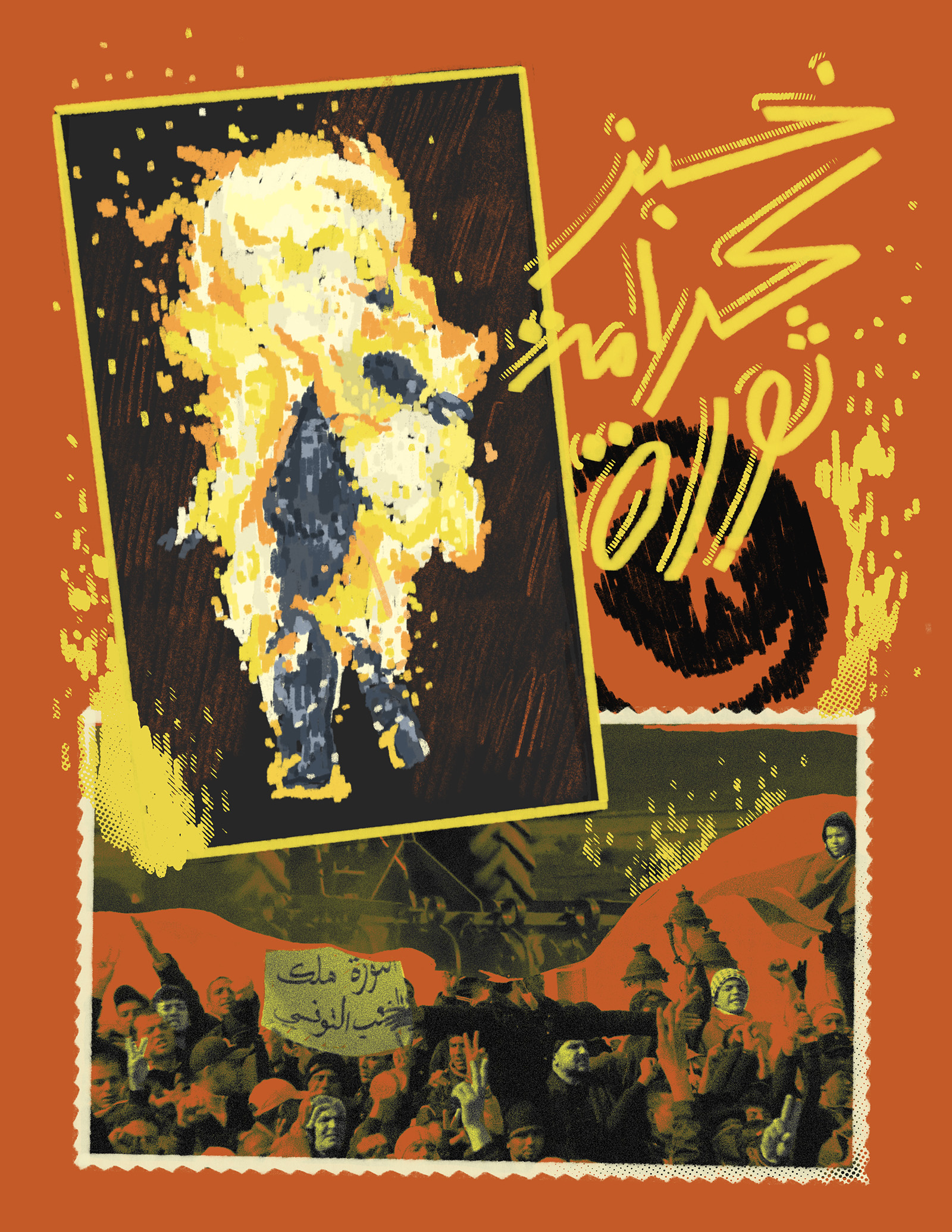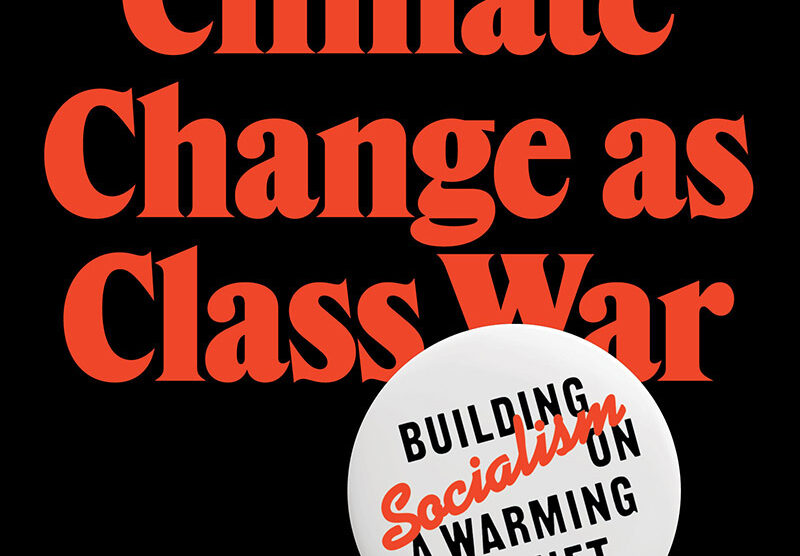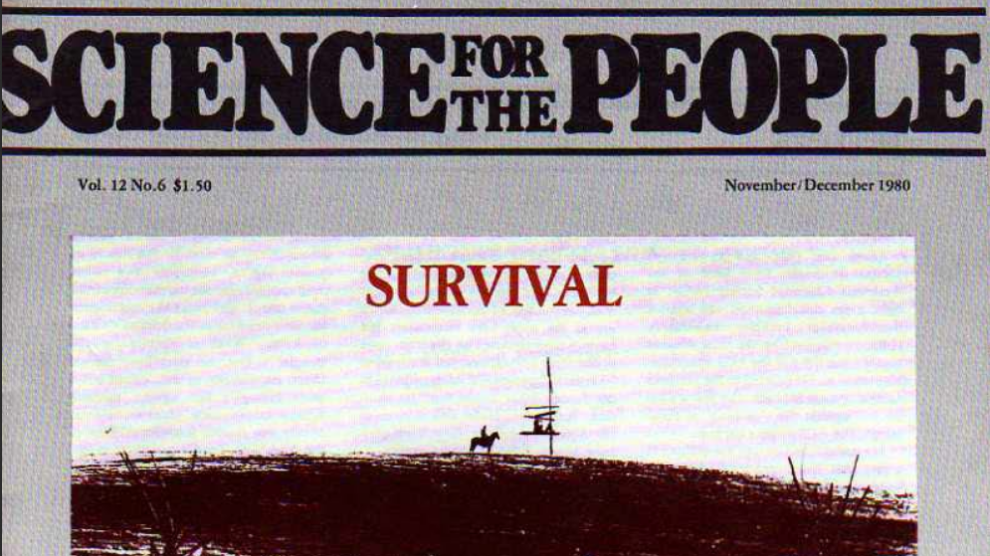Springtime for Food Sovereignty
By Mostafa Shagar and Nadine Fattaleh
Volume 25, no. 1, The Soil and the Worker

On December 17, 2010, a vegetable seller, Mohamed Bouazizi, walked into the middle of traffic in Tunisia and set himself on fire. This self-immolation would later be cited as the cause for the Tunisian protests of 2011 leading to the ousting of then-president Zine El Abidine Ben Ali. The Tunisian “Jasmine Spring,” as commentators were quick to dub the uprisings, is arguably what jostled the foundations of autocratic regimes, and brought insurrection across diverse terrains of struggle in the Arab world. Behind the glitz of mainstream media celebrating urban-based demands for “bread, freedom, and social justice,” few sought to question who Bouazizi was, and where he stood amidst the class dynamic that tethered the city to the countryside. Ten years on, a small but growing field of scholarship seeks a reappraisal of the so-called Arab Spring, situating it within a trajectory of rural disenfranchisement and dispossession, or what Max Ajl memorably terms a long, “agrarian winter.”1
Outstanding among these literature was Habib Ayeb’s and Ray Bush’s urgent book Food Insecurity and Revolution in the Middle East and North Africa—a descriptive and exacting account of at least a century of transformations of agriculture on the peripheries of the global capitalist system. While it describes food and farming through a common thread of economic reform, imperial warfare, and compounding environmental stress across the Middle East and North Africa, it examines most closely the cases of Tunisia and Egypt, where the authors share long and rich careers of scholarship and activism.2 Rather than singling out individual events and drawing out deterministic inferences, Ayeb’s and Bush’s analysis follows a simple premise: it documents the “pressures and constraints that farmers have had to deal with,” examining the “myriad and largely negative policy interventions that have undermined, and often displaced farmers and communities with little provision and opportunity for alternative non-agricultural livelihoods” (p. 1)—in other words, the interconnected material conditions that engendered the Arab Spring.
Working within the tradition of political economy, Ayeb and Bush offer an enlivened debate that builds upon and extends the influential work of Egyptian Marxist sociologist Samir Amin, centering dynamics of capital accumulation as they configure the relationship between the center and the periphery, operating at the scales of the Global North and the Global South, but also within Tunisia and Egypt between the metropolitan cities and the agrarian countryside.3 The temporality of these parasitic relationships spans decades: it results from “a long accumulation of privatizations, exclusions, humiliations and dispossessions, and also of resistance” (p. 55). In broad strokes, the story goes as follows: after independence, Egypt and Tunisia sought to foster a modern, productivist, export-oriented agriculture sector where produce was extracted from the periphery (the South), and conveyed to the center (the North) to be processed and exported. The glimmering exception to this trend was Nasserist Egypt (1956–70), which promoted an egalitarian redistribution of land until it was quickly reversed under the Sadat presidency (1970–81). The disenfranchisement and dispossession accelerated in the 1980s, when markets for land and agricultural inputs were liberalized and social safety nets available to the masses were eroded in line with the “recommendations” (read: compulsion) of international financial institutions like the IMF and the World Bank. If this pattern sounds familiar, it’s because it has been the global norm under the regime of neoliberalism. First signs of protest against poor conditions of existence began to emerge from the rural classes during the bread riots of 1984 (Tunisia) and 1977 (Egypt), in many ways prefiguring a link to the protests of the early 2010s.
 To better understand these socio-spatial processes of rural immiseration, let’s consider the emblematic case of Mohamed Bouazizi’s suicide. While Western analysts and Arab liberals preferred to caricature him as an unemployed urban youth, Ayeb’s fieldwork in the central district of Sidi Bouzid, Bouazizi’s hometown, would suggest otherwise. Sidi Bouzid was the site of intense rural unrest in June–July 2010, in the months directly preceding the Tunis-based insurrection. Groups of farmers organized sit-ins voicing a broad range of demands, from access to water, farmland, subsidies, and agricultural inputs. Since the mid-1990s, while capital flows into the area nearly doubled the acreage of available agricultural land, poverty rates increased and groundwater accessible to small farmers dried up. In addition was the growing problem of accumulated debt that hit peasant families like Bouazizi hard. Development experts tend to inculpate small farmers’ laziness, apathy, and mismanagement in their inability to pay back mortgage loans, drawing from familiar colonial tropes. But Bouazizi’s family lost their means of production at the hands of systematic and predatory lending practices, where collusion between local banks and foreign investors orchestrated land grabs from the poorest and most marginalized. No longer able to sow and cultivate the soil passed down through generations, Bouazizi’s uncle affirms: “the reason [Mohammad] did it is because the land was taken away. It’s all linked. I want you to understand the link” (p. 72).
To better understand these socio-spatial processes of rural immiseration, let’s consider the emblematic case of Mohamed Bouazizi’s suicide. While Western analysts and Arab liberals preferred to caricature him as an unemployed urban youth, Ayeb’s fieldwork in the central district of Sidi Bouzid, Bouazizi’s hometown, would suggest otherwise. Sidi Bouzid was the site of intense rural unrest in June–July 2010, in the months directly preceding the Tunis-based insurrection. Groups of farmers organized sit-ins voicing a broad range of demands, from access to water, farmland, subsidies, and agricultural inputs. Since the mid-1990s, while capital flows into the area nearly doubled the acreage of available agricultural land, poverty rates increased and groundwater accessible to small farmers dried up. In addition was the growing problem of accumulated debt that hit peasant families like Bouazizi hard. Development experts tend to inculpate small farmers’ laziness, apathy, and mismanagement in their inability to pay back mortgage loans, drawing from familiar colonial tropes. But Bouazizi’s family lost their means of production at the hands of systematic and predatory lending practices, where collusion between local banks and foreign investors orchestrated land grabs from the poorest and most marginalized. No longer able to sow and cultivate the soil passed down through generations, Bouazizi’s uncle affirms: “the reason [Mohammad] did it is because the land was taken away. It’s all linked. I want you to understand the link” (p. 72).
Ayeb and Bush are adamant to draw causal lines in the reverberations of rural discontent across Egypt and Tunisia beyond just the case of Bouazizi and his family’s fate. They display a penchant to map rural disapproval and solidarity onto the cartography of material formations and class struggle, characterized as nothing short of the “agrarian origins of regime change.”
Alongside the political and ethical imperative of re-centering the narrative of the voiceless peasants, Ayeb and Bush also usefully disrupt normative discourses on “food security,” which have found renewed interest in policy circles increasingly drawn to statistical correlation between food prices and political volatility that algorithmically predict food riots. As such, issues of power and uneven access remain veiled behind Foreign Direct Investments, big capital, and export-crop models, and international organizations like the Food and Agriculture Organization insist on market-based solutions for ensuring access to food. Farmers suffering underdevelopment and poverty are kept out of these transnational entities making life-and-death policy decisions based on what economists dub the “comparative advantage.” This alchemy of interests consigns small-scale farmers to the production of cash crops whose export would support import of basic food products, namely cereals, while the terms of engagement are all set in the North for the purpose of siphoning and transferring value from the South. The authors insist that national discussions of food security should be mirrored in agricultural agendas free from the hegemony of investors and “modernizers.”
The enduring power of the book is its ability to chart a different path for emancipatory possibilities.
Conversations around agricultural and farming in the Arab world continue to be articulated through the same tired lens of “food security,” citing environmental stress, political “instability,” and the Malthusian fear of accelerated population growth to support capitalist, trade-based approaches to food provisioning in the region. The enduring power of the book is its ability to chart a different path for emancipatory possibilities, documenting and expanding on alternatives emerging from a grassroots level that cohere around demands of access to land, water, agricultural inputs, markets, and government support. The Arab world has historically been underrepresented in both scholarship and global social movements around agriculture,4 but people’s demands are starting to converge and more clearly identify with the Food Sovereignty movement which enjoys wide popularity across the Global South. First coined in 1996 by La Via Campesina (LVC), a movement of peasant farmers, “food sovereignty” has become an alternative method of agrarian change that focuses on fair distribution of land and natural resources, and self-determination of food policy by the people.
The promotion of local agriculture will neither happen overnight, nor through the independent whim of committed small producers. Signs of change are emerging across the region, with youths investing in farming and experimenting with novel technologies and social formations. In the context of Palestine, for example, young people are forming cooperatives, while the Union of Agricultural Work Committees, who is the regional coordinator of LVC, persists in spite of defamation campaigns by Zionist settlers. However, broader structural conditions need to follow these emerging trends in order to support greater autonomy of markets in the South and increased independence from the strictures of the global capitalist system and its metabolic appropriation of profits from peasant producers. National sovereignty was once (and should become) the guiding framework for alternative models of development which drew from Samir Amin’s theories of dependency and delinking, emphasizing the role of indigenous labor and technology.
Ayeb and Bush find optimism in their reappraisal of the horizons of possibility from the historical pinnacle of the Non-Aligned Movement, when newly independent states across the South touted progressive national development policies supporting the redistribution of land liberated from colonial rule, and established the provision of food as the cornerstone of their social contract with citizens. These nominal wins during the postwar decolonization struggle were reversed by the liberalization of the 1980s, the influx of global financial institutions, and the neoliberal policies that eviscerated the rural hinterlands. The authors also seem pessimistic about the possibilities of today. Although the post-revolutionary Egyptian constitution of 2014, for example, included a clause affirming food sovereignty following farmer mobilizations, their diagnosis is that it has had little significant impact on the ground. Despite greater visibility given to rural issues, comprador capitalists and their foreign beneficiaries have doubled down on dispossession, with frontier extraction, land grabs, the transformation of agribusiness continuing unabated, and at accelerated rates.
The urgency of rethinking our capitalist global food system from the particularities of local contexts in the Arab world will continue to grow with the coming catastrophes. The recent escalation of conflict in Ukraine has been particularly alarming given concerns over shortages of international shipments of wheat. Ukraine and Russia provide about a quarter of the world’s supply, satisfying, for example, about 70 percent of Egypt’s wheat imports. In breaking the chain of import dependence and achieving food sovereignty, the demands of the people and social movements have and will continue to lead the way. The Jordanian government, for example, has recently moved to reconsider the availability of land and feasibility of irrigation infrastructure specifically for cereal cultivation which had been on the backburner of agricultural policy for at least three decades.5 This has been the result of years of on the ground activism, perhaps most visibly by a grassroots organization called Al-Baraka Wheat. Since 2019, Al-Baraka (or “blessing”), has encouraged the community to join educational efforts around sowing and harvesting wheat on uncultivated land as well as raising awareness about Jordan’s 97 percent crop import dependence. The success of this mobilization to induce lasting legislative changes on the ground remains to be seen.6 Nevertheless, the core messages of both the book, and the grassroots initiatives for food sovereignty in the Arab world more broadly, is to more loudly and visibly articulate the urgency and hope embedded in agrarian struggles.
Food Insecurity and Revolution in the Middle East and North Africa: Agrarian Questions in Egypt and Tunisia
Habib Ayeb and Ray Bush
Anthem Press
2019
216 pages
Notes
- Max Ajl, “Does the Arab Region Have an Agrarian Question?” The Journal of Peasant Studies 48, no. 5 (2021): 955–983.
- See ROAPE, “Justice, Equality, and Struggle—An Interview with Ray Bush,” Review of African Political Economy Blog, November 9, 2021, https://roape.net/2021/11/09/justice-equality-and-struggle-an-interview-with-ray-bush/; Max Ajl, “Food Sovereignty and the Environment: an interview with Habib Ayeb,” Review of African Political Economy Blog, April 12, 2018, https://roape.net/2018/04/12/food-sovereignty-and-the-environment-an-interview-with-habib-ayeb/
- Samir Amin, Accumulation on a World Scale: A Critique of the Theory of Underdevelopment (New York: Monthly Review, 1974).
- See Ajl, “Food Sovereignty and the Environment.”
- Marta Vidal, “Russia-Ukraine war: Calls for Middle East food sovereignty amid looming wheat crisis,” Middle East Eye, March 18, 2022, https://www.middleeasteye.net/news/russia-ukraine-war-middle-east-food-sovereignty-looming-wheat-crisis.
- Naziha Sa’eed, “Depleted Food Security” … Jordan Wakes up to the Reality of the Wheat Crisis [Arabic],” Raseef 22, April 11, 2022, https://raseef22.net/article/1087283-أمن–غذائي–هش–الأردن–تصحو–على–واقع–أزمة–القمح.





